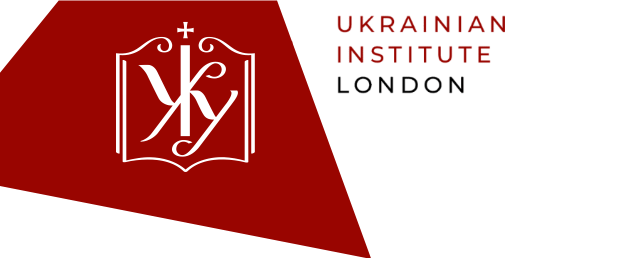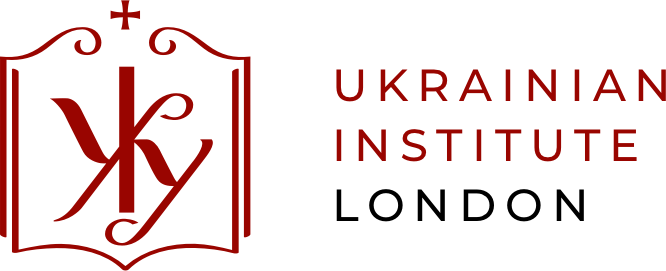On Monday, September 22, 2014 Yevhen Hlibovytsky gave a presentation at the Ukrainian Institute London entitled ‘Reintroducing Ukraine: a new set of assumptions for what Ukraine is, and is not.’ He discussed the evolution of values in Ukraine, changes in institutions and a new role for Ukraine in the region, and outlined recent events on Maidan and in Ukraine in a wider context of culture, history and politics.
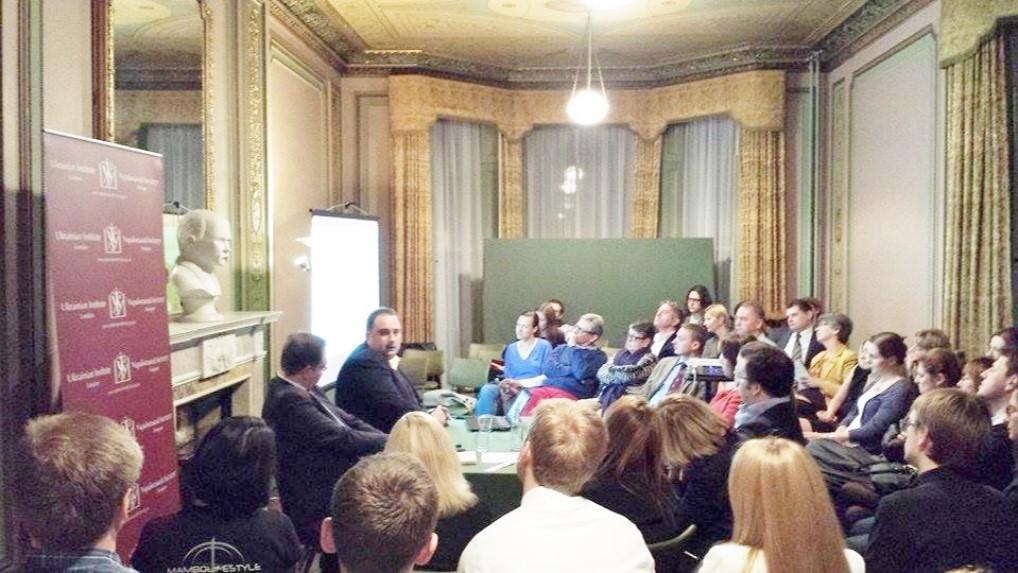
AUTHOR
Yevhen Hlibovytsky, founder of think tank and strategic consultancy pro.mova and member of The Nestor Group – an independent expert group which designs a long term vision for Ukraine. Yevhen Hlibovytsky also does expert work for OSCE in Central Asia, the Caucasus and other post-Soviet countries.
I selected three important assumptions, which, it seems to me, often lay the foundation of perceptions of Ukraine:
1) Ukraine is a post-Soviet Eastern European state, which generally shares the same development problems as the other former republics, and is lagging behind Russia institutionally;
2) Ukraine is a state split between East and West; language and ethnicity define the divide in Ukraine;
3) Ukraine has little value to bring to the European table.
I must admit that too little scientific data lies behind my conclusions (it is often simply unavailable, sometimes by the time some data is interpreted it is not relevant anymore, and many things are still waiting to be researched), so please, take my further statements critically. However, based on my experience I wouldn’t take them sceptically.
I believe that all three assumptions are inaccurate, and by now the errors have multiplied themselves to the extent that they cannot be tolerated. Let’s take them one by one.
1) Ukraine is a post-Soviet Eastern European state, which generally shares the same development problems as the other former republics, and is lagging behind Russia institutionally
Categorising Ukraine as Eastern Europe is rooted in the early days after the fall of the USSR, when the West had to comprehend all these new bodies. As only institutional reliable data was available, and cultural was not – all former republics were categorised after Russia as “Eastern European”. A position on the map was obvious enough to prove the statement. Institutionally, Estonia and Azerbaijan were in the same boat in the early 90s. And those countries that have not joined the EU have largely remained institutionally similar until now. Slide 5
A good 10-15 years after the formation of these new states, interpretations of cultural research started. My conclusions from my work at the Univska group (vision for Lviv-2025), The Nestor Group (long term vision for Ukraine), similar groups in Dnipropetrovsk, Yaremche, and beyond Ukraine (Georgia, Kyrgyzstan etc.) that I was either part of, or interacted with, lead me to challenge the perception that “Russia is the centre, and everyone else is a deviation from Russia” or “Ukraine is just a softer version of Russia”.
Comprehending Ukraine’s governance struggles is much easier if we have Greece or Southern Italy in mind rather than Russia, Belarus or Georgia.
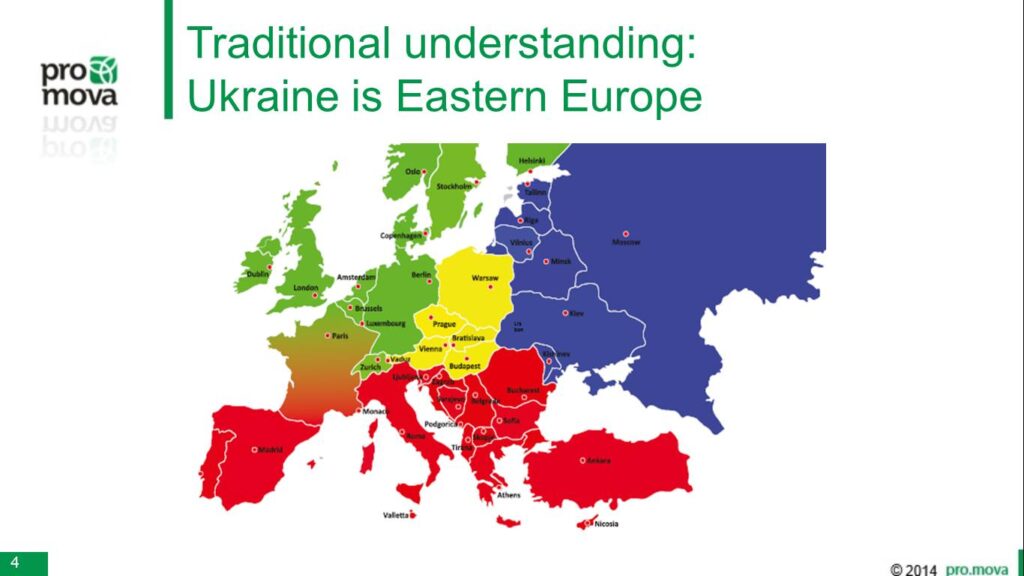
Russia is a highly centralised country, where a citizen stands no chance in an open standoff with the state. Major decisions are taken at the top, and are later conveyed down below. Ukraine cannot be a softer version of this model, as it is exactly the opposite: this is a decentralised country, where the grass roots define “a framework of the possible”, major decisions are made not at the top, but are accepted at the top after they reach the critical mass in society. I would actually claim that the state has little chance in a standoff with a citizen. Ukrainians have perfected their skill of using corruption to dismantle authority, undermining central government capacity. This puts Ukraine much closer to Southern Europe than to Eastern Europe. Comprehending Ukraine’s governance struggles is much easier if we have Greece or Southern Italy in mind rather than Russia, Belarus or Georgia.
Image: Slide 4 of Yevhen Hlibovytsky’s presentation, showing the traditional perception of Ukraine as “Eastern Europe”.
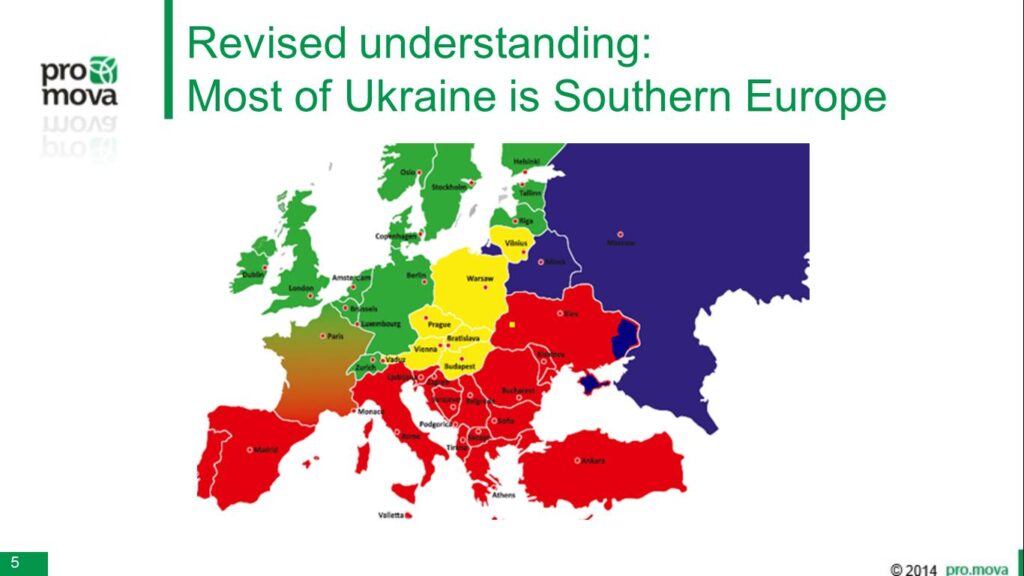
The Russia-centric perception of “Ukraine repeating the Russian way with a few years’ delay” may be explained by the fact that Russia is in fact developing or modernising its autocratic institutions. Ukraine really lags behind in this, as Ukraine tries to develop – often unsuccessfully – democratic institutions. Judging cats on how they bark will produce similar outcomes – cats appear to never reach puppy state in their development.
Image: Slide 5 of Yevhen Hlibovytsky’s presentation, showing how it could be appropriate to consider Ukraine in terms of “Southern Europe”.
2) Ukraine is a state split between East and West; language and ethnicity define the divide in Ukraine
Ukraine really is split if we accept that identity issues (language, religious denominations, historic narratives etc.) are decisive factors in decision-making. Sociological data tells us that identity issues are secondary to security ones (physical survival, rule of law, corruption, opportunities etc.). However, the control of the ruling elites over the media in Ukraine, unchallenged by weak civil society, allowed them to manipulate the agenda for some good 20 years. If identity is applied – we have a split. If security is applied (like Leonid Kuchma exceptionally did during his re-election campaign in 1999) – there is little difference in how Ukrainians see themselves.
The Nestor Group has challenged the perception of Ukraine as a sum of the regions – the generalisation seems to be quite misleading. We observe a set of about a dozen different urban and rural communities with different settings of planning horizon, assertiveness, uncertainty avoidance etc., which create a variety of diverse cultures melted/integrated in Kyiv, a soft and inclusive platform for the whole country.
If we were to look for some split in Ukraine, it would rather be in the reflection of the geopolitical East/West conflict. In these terms the border between East and West has actually shifted eastwards more than 1000km in the last 25 years, including predominantly Russian-speaking territories which at the same time look for European pluralism and acceptance versus the discriminatory Soviet system. Language, religion and ethnicity in modern Ukraine contribute increasingly less to identity. Unlike what is usually the case in Europe, but like on the American continent, one becomes a Ukrainian when one feels like a Ukrainian – an important difference to observe.
3) Ukraine has little value to bring to the European table
This is something which Ukrainian experts often hear in the EU, and it shows how little European decision-makers believe Russia and other post-Soviet countries matter for the sustainability of EU development.
The current Russian crisis at the very least will cost European countries an increase in security spending, and threaten some countries with being uncomfortably cold during the winter, but it can also restrain trade and hold back certain industries – enough to ignite recession.
The EU possesses great resources and strong institutions, but it has little capacity to interpret Russian culture.
The EU possesses great resources and strong institutions, but it has little capacity to interpret Russian culture and to see how Russian imperialism can become the greatest challenge to the current reading of European values after Nazism. Ukraine, whose determination to transform Russia into a democratic and peaceful state is defined by pure need of survival, has exactly what the EU lacks: the ability to understand and interpret Russia, and to make a contribution to the formation of a common long-term policy towards transformation in the former USSR.
Should Ukraine be neglected, rejected or cease to exist – the EU will remain one-on-one with a threat to which it has few tactical tools to match Russia’s blunt and short-time effective advances.
The full presentation is available on Yevhen Hlibovytsky’s Facebook page.
